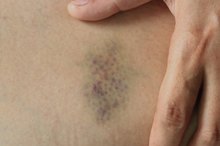What does fact checked mean?
At Healthfully, we strive to deliver objective content that is accurate and up-to-date. Our team periodically reviews articles in order to ensure content quality. The sources cited below consist of evidence from peer-reviewed journals, prominent medical organizations, academic associations, and government data.
The information contained on this site is for informational purposes only, and should not be used as a substitute for the advice of a professional health care provider. Please check with the appropriate physician regarding health questions and concerns. Although we strive to deliver accurate and up-to-date information, no guarantee to that effect is made.
How to Get Rid of a Hematoma
A hematoma is a pooling of blood in a localized area under the skin. Contusions (bruises) are mild forms of hematomas. Injuries such as falls and sprains cause hematomas, resulting in bumpy, reddish-purple or dark blue discoloration, swelling and tenderness. Head trauma could cause a more dangerous form of a hematoma, placing pressure on the brain. The pooled blood is absorbed by the body over time, unless infection occurs (fever, increased swelling, pain and redness). Medical attention should be sought immediately following any head trauma beyond a simple bump on the noggin or at any sign of infection.
If you are experiencing serious medical symptoms, seek emergency treatment immediately.
Apply ice to the affected area as quickly as possible after injury occurs. Cold reduces arterial blood flow, which decreases bleeding under the skin caused by broken blood vessels, and swelling. In the case of a severe fall or blunt trauma, seek medical attention to check for fractures.
How to Care for a Bruised Knee
Learn More
Elevate injured area, using pillows or blankets, above your heart, if possible. This will reduce blood flow to the injury and alleviate further swelling.
Protect the injured area by wrapping it with an elastic bandage. This also will help in reducing swelling and pooling of blood. Apply gentle pressure when wrapping–if it is too tight it could block blood flow completely, resulting in numbness and pain.
How to Treat Muscles Pulled From Bones
Learn More
Optional
Take an over-the-counter medication containing ibuprofen or acetaminophen for pain. Both medications reduce pain by reducing inflammation.
- Apply ice to the affected area as quickly as possible after injury occurs.
- Apply gentle pressure when wrapping–if it is too tight it could block blood flow completely, resulting in numbness and pain.
Continued Care
Rest injury as much as possible (especially within the first 48 hours) by avoiding any activity that could cause further harm, pain or swelling. The use of a brace of a sling may be helpful in gaining mobility, however, care must be taken to allow the injury to heal properly. A physician can advise you on how much is too much.
Continue to apply ice the first 48 hours following injury every two to three hours for 15 to 20 minutes each time. Consult your physician if you have diabetes or vascular disease before using continued ice therapy.
Continue to elevate injury above your heart as much as possible, especially when sleeping. This will keep swelling to a minimum by allowing built-up fluid to drain away from the area.
Optional: Apply heat using warm towels or a heating pad for 20 minutes every two to three hours after the first 48 hours following injury. This promotes repair and absorption of pooled, clotted blood. Heat increases blood flow to the area. Ice therapy should be used immediately following treatment.
Optional: Take over-the-counter pain medication as needed and as prescribe by the manufacturer. If pain worsens or severe pain persists for more than a week consult with your physician.
Tips
Taking vitamin C daily thickens the walls of blood vessels. It is a preventive way to possibly lessen the extent of damage when an injury occurs.
Applying witch hazel to the injury also acts as an anti-inflammatory and promotes faster healing.
Warnings
Never throw precautions to the wind. Though this article is informative, it in no way is to replace the advice or knowledge of your physician. Even if you think it may be a simple injury, seeking medical attention is most important in ruling out potentially dangerous complications.
- Rest injury as much as possible (especially within the first 48 hours) by avoiding any activity that could cause further harm, pain or swelling.
- Continue to elevate injury above your heart as much as possible, especially when sleeping.
Related Articles
References
Tips
- Taking vitamin C daily thickens the walls of blood vessels. It is a preventive way to possibly lessen the extent of damage when an injury occurs.
- Applying witch hazel to the injury also acts as an anti-inflammatory and promotes faster healing.
Warnings
- Never throw precautions to the wind. Though this article is informative, it in no way is to replace the advice or knowledge of your physician. Even if you think it may be a simple injury, seeking medical attention is most important in ruling out potentially dangerous complications.
Writer Bio
CJ Callen is a work-from-home mother, living in New Jersey. Her articles cover a wide variety of subjects, from DIY and motivation, to vacation and local dining guides. After graduating from Atlantic Cape Community College in 1989, she put her writing career on hold. In 2007 she returned to freelance writing full time.









